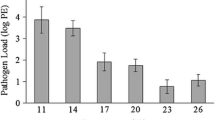Abstract
The biological and environmental factors affecting survival off-the-host of Otodectes cynotis (Acari: Psoroptidae) ear mites were investigated under natural and laboratory conditions. From November 2000 to November 2002 mites were collected monthly from cats and divided into four groups according to sex and stage. In laboratory conditions, the mites were placed in an incubator with a steady 95% relative humidity (r.h.), at 10 °C. All the plates were examined by stereomicroscopy every 24 h until all the mites had died. The data were analysed statistically by multiple linear regression and survival analysis. At 10 °C, the maximum survival time of mites was between 15 and 17 days, while at 34 °C, it was between 5 and 6 days. The maximum survival time of adult females was significantly longer than that of other stages. No differences were observed in maximum survival times of mites that had been offered food and those that had not, or in the time (in days) to reach 50% mortality (LT50). When exposed to environmental conditions, the maximum survival time (12 days) was observed at temperatures ranging from 12.3 to 14.2 °C and r.h.s between 57.6 and 82.9%. Multiple regression analysis showed that temperature alone influenced the maximum survival time and LT50 of mites, and that the rate of survival declined linearly with increasing mean temperature. This basic understanding of off-host survival suggests that, places which have been inhabited by infected animals may need to be disinfected or remain vacated for at least 12 days before occupancy by clean cats or dogs.
Similar content being viewed by others
References
Arlian L.G., Kaiser S., Estes S.A. and Kummel B. 1981. Infestivity of Psoroptes cuniculi in rabbits. Am. J. Vet. Res. 42: 1782–1784.
Baker E. 1974. Ectopic ear mite infestation in the dog. J. Am. Vet. Med. Assoc. 164: 1125–1126.
Baker A.S. 1999. Mites and Ticks of Domestic Animals-An Identification Guide and Information Source. The Natural History Museum, London, UK, pp. 89–91.
Berg P. and Shomer R.R. 1963. Otocariasis in the dog and cat. J. Am. Vet. Med. Assoc. 1430: 1224–1226.
Kraft W., Kraiβ-Gothe A. and Gothe R. 1988. Die Otodectes cynotis-Infestation von Hund und Katze: Erregerbiologie, Epidemiologie, Pathogenese und Diagnose sowie Fallbeschreibungen generalisierter Räuden bei Hunden 16: 409–415.
Liebisch A., Deppe M. and Olbrich S. 1985. Experimental studies on the longevity of mange mites of the species Psoroptes ovis, P. cuniculi and Chorioptes bovis off the host. Deutsche Tierärztliche Wochenschrift 92: 181–185.
Lohse J., Rinder H., Gothe R. and Zahler M. 2002. Validity of species status of the parasitic mite Otodectes cynotis. Med. Vet. Entomol. 16: 133–138.
O'Brien D.J., Gray J.S. and O'Reilly P.F. 1994. Survival and retention of infectivity of the mite Psoroptes ovis off the host. Vet. Res. Commun. 18: 27–36.
Pappas Jr C. and Kartz T.L. 1995. Evaluation of a treatment for the ear mite, Otodectes cynotis, in kittens. Feline Prac. 23: 21–24.
Scherk-Nixon M., Baker B., Pauling G.E. and Hare J.E. 1997. Treatment of feline otoacariasis with 2 otic preparations not containing miticidal active ingredients. Can. Vet. J. 38: 229–230.
Scott D.W., Miller W.H. and Griffin C.E. 1995. Parasitic skin disease. In: Muller, G.H. and Kirk, R.W. (eds) Small Animal Dermatology. Saunders, Philadelphia, USA, pp. 392–468.
Shanks D.J., McTier T.L., Rowan T.G., Watson P., Thomas C.A., Bowman D.D., Hair J.A., Pengo G., Genchi C., Smothers C.D., Smith D.G. and Jernigan A.D. 2000. The efficacy of selamectin in the treatment of naturally acquired aural infestations of Otodectes cynotis on dogs and cats. Vet. Parasitol. 91: 283–290.
Smith K.E., Wall R., Berratua E. and French N.P. 1999. The effects of temperature and humidity on the off-host survival of Psoroptes ovis and Psoroptes cuniculi. Vet. Parasitol. 83: 265–275.
Sotiraki S.T., Koutinas A.F., Leontides L.S., Adamama-Moraitou K.K. and Himonas C.A. 2001. Factor affecting the frequency of ear canal and face infestation by Otodectes cynotis in the cat. Vet. Parasitol. 96: 309–315.
Sweatman G.K. 1958. Biology of Otodectes cynotis, the ear canker mite of carnivores. Can. J. Zool. 36: 849–862.
Tonn R.J. 1961. Studies on the ear mite Otodectes cynotis, including life cycle. Ann. Entomol. Soc. Am. 54: 416–421.
Wilson G.I., Blachut K. and Roberts I.H. 1977. The infectivity of scabies (mange) mites, Psoroptes ovis (Acari: Psoroptidae), to sheep in naturally contaminated enclosures. Res. Vet. Sci. 22: 292–297.
Author information
Authors and Affiliations
Rights and permissions
About this article
Cite this article
Otranto, D., Milillo, P., Mesto, P. et al. Otodectes cynotis (Acari: Psoroptidae): examination of survival off-the-host under natural and laboratory conditions. Exp Appl Acarol 32, 171–180 (2004). https://doi.org/10.1023/B:APPA.0000021832.13640.ff
Issue Date:
DOI: https://doi.org/10.1023/B:APPA.0000021832.13640.ff




